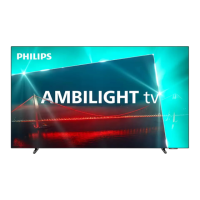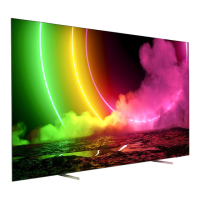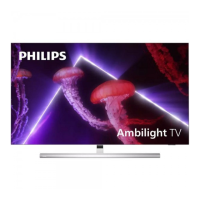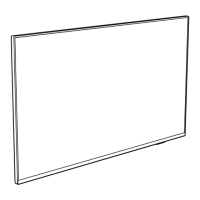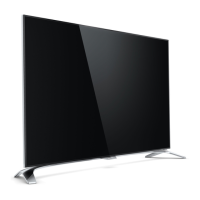Do you have a question about the Philips 55OLED706 and is the answer not in the manual?
Explains the Home screen layout, content discovery via channels, and app recommendations.
How to manage apps, add favorites, and use the Philips TV Collection app.
Step-by-step guide to navigate to and open the Home screen interface.
Information about updates to the Home screen launcher and new features.
Crucial safety instructions to read before operating the TV for the first time.
Guidance on physically installing the TV using its stand or a wall mount.
Recommendations for optimal TV placement regarding lighting and viewing distance.
Instructions for connecting the power cable and safety precautions.
Steps for connecting the antenna cable for TV signal reception.
Detailed explanation of all buttons and their functions on the remote control.
Process for establishing a Bluetooth connection between the remote and the TV.
How to use voice commands for searching content and controlling the TV.
Guide on how to replace the batteries in the remote control.
Methods to turn the TV on, put it in standby, or completely power it down.
Basic TV operations using the physical joystick key on the TV unit.
Steps to install and set up TV channels through antenna or cable.
Information on available channel lists, their organization, and icons.
How to tune into channels, switch between them, and use parental lock features.
Creating, managing, and reordering personalized favorite channel lists.
Covers automatic and manual channel updates, reinstallation, and managing messages.
Procedure for copying channel configurations to another TV via USB.
General advice on connecting external devices for optimal audio and video quality.
Connecting and configuring home theatre systems, soundbars, and receivers via HDMI.
Connecting, formatting, and using USB hard drives for recording and storing apps.
Connecting a computer to use the TV as a monitor, including graphics card notes.
Steps for connecting the TV to a home network, wired or wirelessly.
Signing in with a Google account to access apps, recommendations, and services.
Overview of apps available on the TV from Philips TV Collection and Google Play Store.
Using Google Play for movies, TV shows, games, and installing apps.
Setting up parental controls and restricted profiles to limit app access.
Managing internal TV storage and expanding it with USB hard drives.
Instructions for launching and using the TV's built-in internet browser.
Exploring additional features and settings for the internet browser.
How to navigate and select different input sources and connected devices.
Specific settings for different TV input sources.
Renaming connected devices and assigning appropriate icons in the Sources menu.
Updating the Sources menu by rescanning connected devices.
Information on connecting the TV to various network types.
Pairing and managing wireless Bluetooth devices.
Comprehensive guide to adjusting picture settings for optimal viewing experience.
How to configure sound styles, audio output, and advanced sound features.
Customizing Ambilight effects, styles, and integration with other devices.
Accessing various general configurations like shop mode, USB drive setup, and OLED care.
Viewing media content shared from computers or Network Attached Storage.
Playing media files directly from USB flash drives or hard drives.
Playing music files from USB devices, organizing by genres, and marking favorites.
How to open, navigate, and tune to programs using the on-screen TV Guide.
Setting up, scheduling, and managing TV program recordings, including conflict resolution.
How to pause and resume live TV broadcasts and replay recent content.
Using the mobile app for TV control, media streaming, and remote functions.
Casting content from mobile apps to the TV using Google Cast technology.
Requirements for playing games via Philips TV Collection or Google Play Store.
Connecting and using wireless gamepads for an enhanced gaming experience.
Setting Ambilight effects to follow video, audio, lounge light, or country flag.
Configuring Ambilight for wake-up alarms with music, weather, and lighting effects.
Connecting and configuring Philips Hue bulbs or wireless home speakers with Ambilight.
Understanding personalized content recommendations and terms of use.
Browsing and tuning into current popular TV programs based on recommendations.
Accessing and renting movies and TV shows from online video stores.
Overview of Alexa voice control features and requirements for TV operation.
Step-by-step guide to update the TV's software via internet or USB drive.
How to check the current software version and release notes.
Information regarding product disposal and environmental impact.
Technical details about power consumption and operating conditions.
Listing of all physical ports and wireless connectivity options on the TV.
Specifications of the TV's audio system, including output power and technologies.
Benefits and process for registering the TV to access support services.
Solutions for common operational problems and error messages.
Critical safety precautions to prevent electric shock, fire, injury, or damage.
Guidelines for cleaning the screen and preventing image retention, especially for OLED panels.
Legal terms and conditions governing the use of the television product.
Trademark and licensing information related to HDMI technology.
Copyright and trademark details for Dolby audio and video technologies.
Explains the Home screen layout, content discovery via channels, and app recommendations.
How to manage apps, add favorites, and use the Philips TV Collection app.
Step-by-step guide to navigate to and open the Home screen interface.
Information about updates to the Home screen launcher and new features.
Crucial safety instructions to read before operating the TV for the first time.
Guidance on physically installing the TV using its stand or a wall mount.
Recommendations for optimal TV placement regarding lighting and viewing distance.
Instructions for connecting the power cable and safety precautions.
Steps for connecting the antenna cable for TV signal reception.
Detailed explanation of all buttons and their functions on the remote control.
Process for establishing a Bluetooth connection between the remote and the TV.
How to use voice commands for searching content and controlling the TV.
Guide on how to replace the batteries in the remote control.
Methods to turn the TV on, put it in standby, or completely power it down.
Basic TV operations using the physical joystick key on the TV unit.
Steps to install and set up TV channels through antenna or cable.
Information on available channel lists, their organization, and icons.
How to tune into channels, switch between them, and use parental lock features.
Creating, managing, and reordering personalized favorite channel lists.
Covers automatic and manual channel updates, reinstallation, and managing messages.
Procedure for copying channel configurations to another TV via USB.
General advice on connecting external devices for optimal audio and video quality.
Connecting and configuring home theatre systems, soundbars, and receivers via HDMI.
Connecting, formatting, and using USB hard drives for recording and storing apps.
Connecting a computer to use the TV as a monitor, including graphics card notes.
Steps for connecting the TV to a home network, wired or wirelessly.
Signing in with a Google account to access apps, recommendations, and services.
Overview of apps available on the TV from Philips TV Collection and Google Play Store.
Using Google Play for movies, TV shows, games, and installing apps.
Setting up parental controls and restricted profiles to limit app access.
Managing internal TV storage and expanding it with USB hard drives.
Instructions for launching and using the TV's built-in internet browser.
Exploring additional features and settings for the internet browser.
How to navigate and select different input sources and connected devices.
Specific settings for different TV input sources.
Renaming connected devices and assigning appropriate icons in the Sources menu.
Updating the Sources menu by rescanning connected devices.
Information on connecting the TV to various network types.
Pairing and managing wireless Bluetooth devices.
Comprehensive guide to adjusting picture settings for optimal viewing experience.
How to configure sound styles, audio output, and advanced sound features.
Customizing Ambilight effects, styles, and integration with other devices.
Accessing various general configurations like shop mode, USB drive setup, and OLED care.
Viewing media content shared from computers or Network Attached Storage.
Playing media files directly from USB flash drives or hard drives.
Playing music files from USB devices, organizing by genres, and marking favorites.
How to open, navigate, and tune to programs using the on-screen TV Guide.
Setting up, scheduling, and managing TV program recordings, including conflict resolution.
How to pause and resume live TV broadcasts and replay recent content.
Using the mobile app for TV control, media streaming, and remote functions.
Casting content from mobile apps to the TV using Google Cast technology.
Requirements for playing games via Philips TV Collection or Google Play Store.
Connecting and using wireless gamepads for an enhanced gaming experience.
Setting Ambilight effects to follow video, audio, lounge light, or country flag.
Configuring Ambilight for wake-up alarms with music, weather, and lighting effects.
Connecting and configuring Philips Hue bulbs or wireless home speakers with Ambilight.
Understanding personalized content recommendations and terms of use.
Browsing and tuning into current popular TV programs based on recommendations.
Accessing and renting movies and TV shows from online video stores.
Overview of Alexa voice control features and requirements for TV operation.
Step-by-step guide to update the TV's software via internet or USB drive.
How to check the current software version and release notes.
Information regarding product disposal and environmental impact.
Technical details about power consumption and operating conditions.
Listing of all physical ports and wireless connectivity options on the TV.
Specifications of the TV's audio system, including output power and technologies.
Benefits and process for registering the TV to access support services.
Solutions for common operational problems and error messages.
Critical safety precautions to prevent electric shock, fire, injury, or damage.
Guidelines for cleaning the screen and preventing image retention, especially for OLED panels.
Legal terms and conditions governing the use of the television product.
Trademark and licensing information related to HDMI technology.
Copyright and trademark details for Dolby audio and video technologies.
| Screen shape | Flat |
|---|---|
| Response time | - ms |
| Display diagonal | 55 \ |
| Display brightness | - cd/m² |
| Display technology | OLED |
| Native aspect ratio | 16:9 |
| Native refresh rate | 120 Hz |
| Supported video modes | 1080p, 1440p, 2160p |
| Screen format adjustments | 4:3, 16:9 |
| Supported graphics resolutions | 1920 x 1080 (HD 1080), 2560 x 1440, 3840 x 2160 |
| Motion interpolation technology | - |
| Tuner type | Analog & digital |
| Auto channel search | Yes |
| Analog signal format system | PAL, SECAM |
| Digital signal format system | DVB-C, DVB-S, DVB-S2, DVB-T, DVB-T2, DVB-T2 HD |
| Video apps | Amazon Prime Video, BBC iPlayer, Disney+, Netflix, YouTube |
| Operating system version | 10 |
| Operating system installed | Android |
| Audio decoders | DTS, Dolby Atmos, Dolby Digital |
| Subwoofer type | Active subwoofer |
| RMS rated power | 10 W |
| Number of speakers | 2 |
| Wi-Fi standards | 802.11a, 802.11b, 802.11g, Wi-Fi 4 (802.11n), Wi-Fi 5 (802.11ac) |
| Bluetooth version | 5.0 |
| Product color | Metallic |
| Housing material | Plastic |
| Panel mounting interface | 300 x 300 mm |
| Processor cores | 4 |
| Teletext standards | Hyper-text |
| Audio formats supported | AAC, MP3, WAV, WMA, WMA-PRO |
| Image formats supported | BMP, GIF, HEIF, JPEG, PNG |
| Video formats supported | AVC, AVI, H.264, H.265, HEVC, MKV, MPEG1, MPEG2, VP9 |
| Video compression formats | H.264, H.265 |
| Subtitle formats supported | SMI, SRT, SUB, TXT |
| High Dynamic Range (HDR) technology | Dolby Vision, High Dynamic Range 10 (HDR10), High Dynamic Range 10+ (HDR10 Plus), Hybrid Log-Gamma (HLG) |
| PC in (D-Sub) | No |
| USB 2.0 ports quantity | 3 |
| Ethernet LAN (RJ-45) ports | 1 |
| USB 3.2 Gen 1 (3.1 Gen 1) Type-A ports quantity | 0 |
| Programming period | 8 day(s) |
| AC input voltage | 220 - 240 V |
| AC input frequency | 50 - 60 Hz |
| Energy efficiency scale | A to G |
| Power consumption (standby) | 0.3 W |
| Power consumption (typical) | - W |
| Package type | Box |
| Package depth | 160 mm |
| Package width | 1400 mm |
| Package height | 860 mm |
| Package weight | 27900 g |
| Harmonized System (HS) code | 85287280 |
| Stand width | 797.5 mm |
|---|---|
| Depth (with stand) | 230 mm |
| Width (with stand) | 1227.8 mm |
| Height (with stand) | 722.4 mm |
| Weight (with stand) | 19400 g |
| Depth (without stand) | 58 mm |
| Height (without stand) | 705.6 mm |
| Weight (without stand) | 19000 g |
